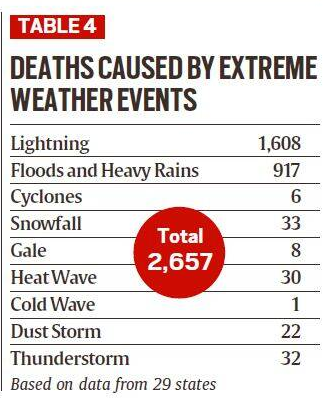Geography
India's Climate and Weather Trends
- 04 May 2023
- 7 min read
For Prelims: EL Nino, Southwest Monsoon Season, Heatwaves.
For Mains: El Nino on India's monsoon season, role of climate change in the increasing frequency and intensity of extreme weather events in India.
Why in News?
Although India has received some rain recently, experts predict that the year 2023 will be hotter and drier.
- The Indian Meteorological Department (IMD) has predicted a normal monsoon, but the development of El Nino could lead to a reduction in monsoon rainfall.
- Additionally, the IMD has released data on fatalities caused by extreme weather events, marking the first time they have done so.
What is the Current Situation in India?
- Uneven Rainfall Distribution:
- Despite the recent showers, the entire country has received ample rainfall, except for the northeastern states, Jharkhand, and West Bengal.
- Some areas in Maharashtra, Gujarat, Uttar Pradesh, and Madhya Pradesh have experienced up to 15 times more rainfall than expected due to various local weather phenomena.
- El Nino and Global Warming:
- The IMD has predicted normal monsoon, but the development of El Nino could suppress rainfall over India.
- Globally, 2023 is expected to be one of the top four warmest years on record due to the rapid development of the El Nino event, which has an overall warming impact on the planet.
- India's Warming Trend:
- India's warming trend is slightly lower than the global average, with the year 2022 being 1.15 degree Celsius warmer than pre-industrial times.
- The warming over India is not uniform across regions. Some states like Himachal Pradesh, Goa, and Kerala have become much hotter than others, while eastern states such as Bihar, Jharkhand, and Odisha have experienced the least warming.
- Sea surface temperatures in the tropical Indian Ocean have risen by almost one degree Celsius between 1950 and 2015.
What do the Climate Models Say About the Impact of Upcoming El Nino?
- Weak Monsoon for India: The development of an El Nino in May or June 2023 may cause a weakening of the southwest monsoon season, which brings around 70% of the total rainfall India receives and on which most of its farmers still depend.
- However, sub-seasonal factors such as the Madden-Julian Oscillation (MJO) and monsoon low-pressure systems can temporarily enhance rainfall in some parts as witnessed in the year 2015.
- Hot Temperatures: It may also cause heatwaves and droughts in India and other regions around the world such as South Africa, Australia, Indonesia and the Pacific Islands.
- Heavier Rainfall in the West: It brings heavy rainfall and flooding to other regions such as California in the United States and could cause bleaching and death of coral reefs.
- Rising Global Average Temp:
- The El Nino in 2023 and going into 2024 may push the global average temperature towards 1.5°C warmer than the preindustrial average.
- The warming of the oceans is also one of the major impacts of an El Nino event.
- This is when ocean heat content is already at a record high, according to the World Meteorological Organization (WMO).
Which Weather Event Causes the Most Fatalities?
- Lightning strikes caused more deaths than any other weather event in India.
- In 2022, lightning strikes were responsible for 60% of weather event-related deaths in India (1,608 out of 2,657 recorded deaths).
- Floods and extreme rainfall events claimed 937 lives.
- The actual number of casualties could be higher, as IMD and state governments relied on media reports to compile the list.
What are India's Climate Change Mitigation Initiatives?
- National Action Plan on Climate Change (NAPCC):
- Launched in 2008 to address climate change challenges in India.
- Aims to achieve low-carbon and climate-resilient development for India.
- There are 8 national missions forming the core of the NAPCC which represent multi-pronged, long term and integrated strategies for achieving key goals in climate change. These are-
- National Solar Mission
- National Mission for Enhanced Energy Efficiency
- National Mission on Sustainable Habitat
- National Water Mission
- National Mission for Sustaining the Himalayan Ecosystem
- National Mission for A Green India
- National Mission for Sustainable Agriculture
- National Mission on Strategic Knowledge for Climate Change.
- Nationally Determined Contributions (NDC):
- India's commitments to reduce greenhouse gas emissions and adapt to climate change.
- Pledged to reduce the emissions intensity of GDP by 45% by 2030 from 2005 levels and generate 50% of electricity from non-fossil fuel sources by 2030.
- Pledged to create additional carbon sink and achieve net zero emissions by 2070.
- National Adaptation Fund on Climate Change (NAFCC):
- Established in 2015 to provide financial assistance to state governments for implementing adaptation projects in various sectors.
- State Action Plan on Climate Change (SAPCC):
- Encourages all states and union territories to prepare their own SAPCCs based on their specific needs and priorities.
- SAPCCs outline strategies and actions for addressing climate change at the sub-national level.
- Aligned with the objectives of the NAPCC and the NDC.
UPSC Civil Services Examination Previous Year Question (PYQ)
Prelims
Q. With reference to ‘Indian Ocean Dipole (IOD)’ sometimes mentioned in the news while forecasting Indian monsoon, which of the following statements is/are correct? (2017)
- IOD phenomenon is characterised by a difference in sea surface temperature between tropical Western Indian Ocean and tropical Eastern Pacific Ocean.
- An IOD phenomenon can influence an El Nino’s impact on the monsoon.
Select the correct answer using the code given below:
(a) 1 only
(b) 2 only
(c) Both 1 and 2
(d) Neither 1 nor 2
Ans: (b)
Mains
Q. ‘Climate change’ is a global problem. How India will be affected by climate change? How Himalayan and coastal states of India will be affected by climate change? (2017).





